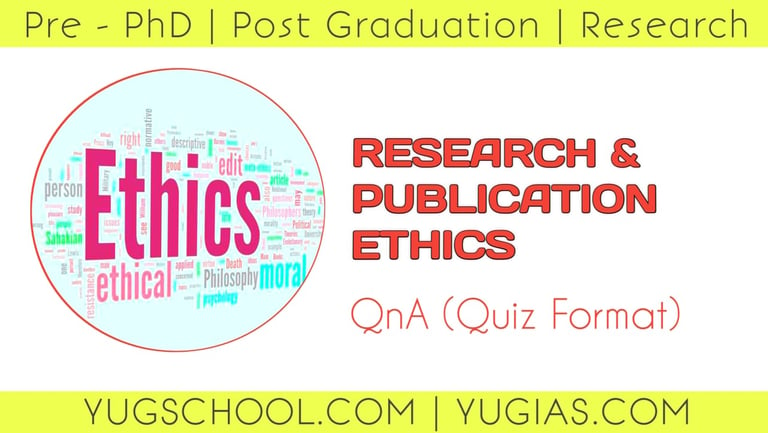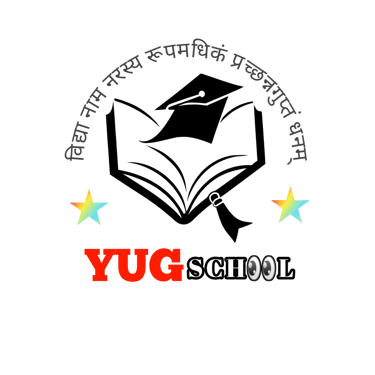Research and Publication Ethics - Questions With Answers
Philosophy is study whose focus of attention is to attain Wisdom. The report on "ethical principles and guidelines for the protection of human subject of research"
HOT TOPICSSOCIOLOGYRESEARCH AND PUBLICATION


Research and Publication Ethics
Questions with answers ( Quiz Format )
1. Philosophy is study whose focus of attention is to attain
Answer: Wisdom
Philosophy, derived from the Greek word "philosophia" meaning "love of wisdom," fundamentally seeks wisdom rather than mere knowledge, data, or information.
2. Philosophy seeks to have a synoptic view of the whole _______.
Answer: Universe
Philosophy aims for a synoptic (comprehensive) view of the entire universe, attempting to understand reality as a whole rather than focusing on individual parts.
3. Who explained the concept of philosophy as that branch of education which evaluates man from animals to the dignity of a human being?
Answer: V R Teneja
V.R. Teneja conceptualized philosophy as the branch of education that elevates humans from animal-like existence to human dignity.
4. From Indian point of view the term "philosophy" is synonymously termed as _______
Answer: darshana
In Indian philosophy, "darshana" (Sanskrit: दर्शन) literally means "to see" or "vision of truth" and refers to philosophical systems.
5. Who defined "Philosophy is the acquisition of knowledge"?
Answer: Plato
Plato defined philosophy as the acquisition of knowledge, emphasizing its role in understanding truth and reality.
6. Who proposed that philosophy as "the great mother of sciences"?
Answer: Francis Bacon
Francis Bacon described natural philosophy as "the great mother of the Sciences" in his work Novum Organum.
7. Who is the author of the book "The Problems of Philosophy"
Answer: Bertrand Russell
"The Problems of Philosophy" is a 1912 book by philosopher Bertrand Russell.
8. ORI stands for-
Answer: Office of Research Integrity
The Office of Research Integrity (ORI) is a U.S. government agency that focuses on research integrity, especially in health.
9. The word plagiarism was first used in the English language by-
Answer: Ben Jonson
Ben Jonson first used the term "plagiary" in English in 1601 to describe literary theft.
10. The predatory journals
Answer: Charge APC for publishing the manuscript but do not undertake proper peer review activities
Predatory journals charge article processing charges (APC) but fail to provide adequate peer review or editorial services.
11. Who is the author of the book institute of metaphysics?
Answer: Ferrier
J.F. Ferrier authored "Institutes of Metaphysic" in the 19th century.
12. Knowledge can be acquired through the use of ________ sensory organs.
Answer: five
Knowledge is traditionally acquired through the five sensory organs: sight, hearing, touch, taste, and smell.
13. Who defined "Logic is the science of operation of understanding subservient to the estimation of evidence"?
Answer: J S Mill
John Stuart Mill defined logic as "the science of the operations of the understanding which are subservient to the estimation of evidence".
14. Who defined as "the study of what is right or good in conduct"
Answer: Gisbert
Gisbert defined ethics as the study of what is right or good in conduct.
15. If a good citizen puts his virtue and reason in times of doing then it is classified as __________ of ethics.
Answer: Moral sphere
When citizens apply virtue and reason in their actions, it relates to the Moral sphere of ethics.
16. Ethics may be changeable in respect of _____________.
Answer: Space and time
Ethics can vary across different spaces (cultures/locations) and times (historical periods).
17. __________ is the branch of learning which deals actually the nature of ethical properties, statements, attitude as well as judgment.
Answer: Meta-ethics
Meta-ethics examines the nature of ethical properties, statements, attitudes, and judgments.
18. Which ethics does investigate moral standards which define right and wrong conduct of human being?
Answer: Normative ethics
Normative ethics investigates moral standards that define right and wrong conduct.
19. _________ deals with the critical moral questions and controversial moral aspects relating to human behaviour arise from their practical lives
Answer: Applied ethics
Applied ethics deals with specific moral questions and controversial aspects arising from practical life situations.
20. Who commented "Reasoning is a stepwise thinking with a purpose or goal in mind"?
Answer: Garrett
Garrett described reasoning as stepwise thinking with a purpose or goal in mind.
21. Who is the notable researcher in the domain of development of moral reasoning?
Answer: Kohleberg
Lawrence Kohlberg is the notable researcher in moral reasoning development.
22. Which of the following policy defined research misconduct as fabrication, falsification, Plagiarism in proposing, performing or reviewing research or in reporting research results?
Answer: US Federal Policy
The US Federal Policy defines research misconduct as fabrication, falsification, and plagiarism.
23. Using other people's material without giving proper credit is termed as ______.
Answer: Plagiarism
Plagiarism is using others' material without proper acknowledgment.
24. UNESCO enforces some guidelines in relating to ethical issues in science and technology since _______
Answer: 1970s
UNESCO began enforcing guidelines on ethical issues in science and technology in the 1970s.
25. The Belmont Report" was published in ______.
Answer: 18 April 1979
The Belmont Report on ethical principles for human subject research was published on April 18, 1979.
26. The report on "ethical principles and guidelines for the protection of human subject of research" known as __________.
Answer: The Belmont Report
The Belmont Report established ethical principles for protecting human research subjects.
27. Which organisation does enforce some guidelines in relating to ethical issues in science and technology?
Answer: UNESCO
UNESCO enforces guidelines on ethical issues in science and technology.
28. "Ethical conduct of research [in humanities] was a matter for the conscience of the individual researcher" was defined by
Answer: HERA
HERA defined ethical conduct in humanities research as a matter of individual conscience.
29. Which organisation defined "research misconduct is fabrication, falsification and plagiarism, and does not include honest error or differences of opinion"
Answer: US National Institutes of Health
The US National Institutes of Health defined research misconduct as fabrication, falsification, and plagiarism.
30. Plagiarism is the process of putting one's work, ideas, process, results, etc. without giving proper acknowledgement as per ________.
Answer: ORI, 2007
ORI's 2007 definition addresses plagiarism as using others' work without acknowledgment.
31. Who did first coin the term Plagiarism?
Answer: Poet Martial
Roman poet Martial first used the term "plagiarius" (kidnapper) to describe literary theft.
32. ________ defines "author is the person, persons or corporate body, responsible for the writing or compilation of a book or other publication."
Answer: Harrods Librarian's Glossary
Harrods Librarian's Glossary provides this definition of authorship.
33. Who did define that author is one who is primarily responsible for an artistic content of a document?
Answer: Melvil Dewey
Melvil Dewey defined authorship as primary responsibility for artistic content.
34. Which organisation did prepare the regulation entitled "Promotion of Academic Integrity and Prevention of Plagiarism in Higher Educational Institutions) Regulation, 2018"?
Answer: UGC
The University Grants Commission (UGC) prepared these 2018 regulations.
35. ICMJE recommends ______criteria that can be defined as authorship.
Answer: four
The International Committee of Medical Journal Editors (ICMJE) recommends four criteria for authorship.
36. Which organisation is responsible for formulating the authorship for any document having characteristic as "writer should have to contribute substantial contribution or any design for the work"?
Answer: COPE
COPE formulates authorship criteria including substantial contribution requirements.
37. The conflict of interest exists when two or more contradictory interests relate to an activity by an individual or an institution has been commented by
Answer: ORI
The ORI addresses conflicts of interest.
38. According to _______ Conflicts of interest are "situations in which financial or other personal considerations may compromise, or have the appearance of compromising, an investigator's judgment in conducting or reporting research"
Answer: AAMC
The Association of American Medical Colleges (AAMC) provides this definition of conflicts of interest.
39. In which year, a white document was published by the joint venture of National Academy of Sciences; National Academy of Engineering; Institute of Medicine; Committee on Science, Engineering, and Public Policy; Panel on Scientific Responsibility and the Conduct of Research towards the fostering faculty and student awareness relating to integrity of research process?
Answer: 1992
This comprehensive white paper on research integrity was published in 1992.
40. Who are the authors of the document entitled "The Responsible Public Servant"?
Answer: K Kernaghan and J Langford
K. Kernaghan and J. Langford authored "The Responsible Public Servant."
41. Who did point self-dealing as one of the conflicts of interest ?
Answer: K Kernaghan and J Langford
K. Kernaghan and J. Langford identified self-dealing as a conflict of interest.
42. Who did establish COPE guidelines?
Answer: All of above
M. Farthing, R. Smith, and R. Horton all contributed to establishing COPE guidelines.
43. Which committee did publish "code of conduct" and "best practice guidelines" for publishing the article properly?
Answer: COPE
The Committee on Publication Ethics (COPE) publishes codes of conduct and best practice guidelines.
44. In which year the COPE was established?
Answer: 1997
COPE was established in 1997.
45. Which organisation did publish the document entitled "Guidance Document on Good Academic Research Practices (GARP)" in September, 2020?
Answer: UGC
The University Grants Commission (UGC) published GARP in September 2020.
46. Who did coin the term predatory journal?
Answer: J Beall
Jeffrey Beall coined the term "predatory journal".
47. Complaints are the reaction process happened during the _______ of an article
Answer: post-publication
Complaints typically arise after publication of articles.
48. Appeal is the next process adopted by the ______ after getting negative information regarding the publication of his article from the editorial corner.
Answer: author
Authors file appeals when receiving negative decisions from editors.
49. Which organisations did identify and analyse the fraud cases in USA?
Answer: ORI, US DHHS
The Office of Research Integrity in the US Department of Health and Human Services identifies and analyzes fraud cases.
50. ORI enlisted _______ core instructional areas relating to conducting responsible research and ensuring integrity.
Answer: nine
ORI lists nine core instructional areas for responsible research conduct.
51. Who was the chairman of expert group on good academic research practices 2020?
Answer: R Bhatnagar
R. Bhatnagar chaired the expert group on good academic research practices in 2020.
52. Copyscape is a web-based multilingual support _____ plagiarism software.
Answer: SaaS
Copyscape is a Software as a Service (SaaS) plagiarism detection tool.
53. In which year, Turnitin, came into existence?
Answer: 1998
Turnitin was established in 1998.
54. Through which protocol, does Urkund communicate over HTTP?
Answer: REST based
Urkund uses REST-based protocols for HTTP communication.
55. API stands for
Answer: Application Program Interface
API stands for Academic Performance Indicator.
56. Consortium for Academic and Research Ethics (CARE) for
Answer: the preparation of a new list of credible quality journals for various disciplines
CARE focuses on creating lists of credible journals across disciplines.
57. Committee constituted by Savitri Phule Pune University (SPPU) to address the issues
Answer: To address the issues of Sub-standard publication enlisted in UGC list
SPPU's committee addresses substandard publications in UGC lists.
58. Which of the following is databases to find predatory journals
Answer: Cabell's blacklist
Cabell's blacklist is a database for identifying predatory journals.
59. Budapest Open Access Initiative (2002) is concerned with:
Answer: Open Access publishing
The Budapest Open Access Initiative promotes open access to scholarly publications.
60. Libre is
Answer: Green/Gold Open Access
Libre refers to Green/Gold Open Access, where authors self-archive their work.
SOCIOLOGY | SOCIOLOGY | SOCIOLOGY | SOCIOLOGY
